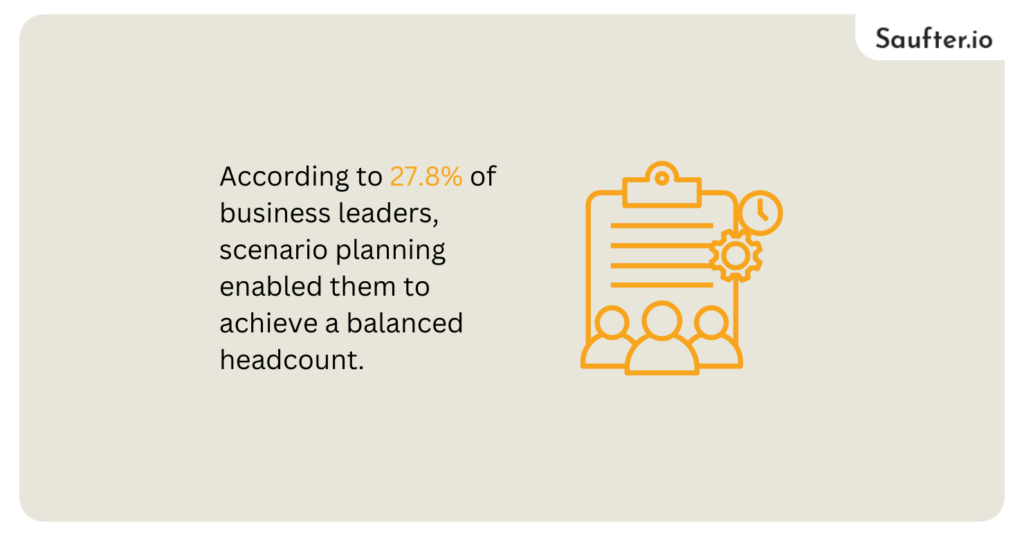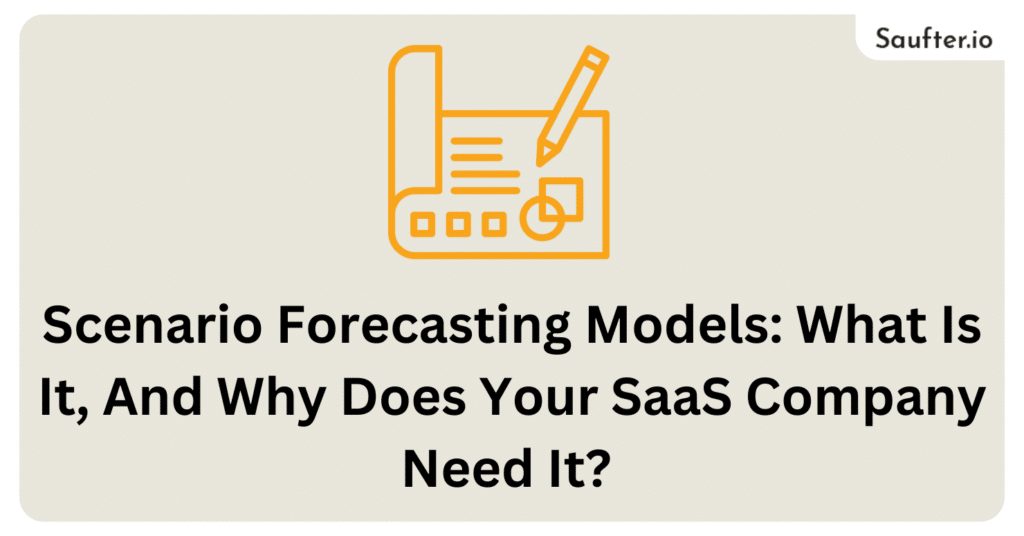Last Updated: December 2025
In the dynamic landscape of Software as a Service (SaaS), understanding the key metrics for subscription business is vital for sustained success. According to 27.8% of business leaders, scenario planning enabled them to achieve a balanced headcount. Scenario forecasting models serve as a strategic method employed by businesses to prepare for various potential futures by exploring alternative outcomes based on visible risks and uncertainties.

This report delves into the fundamentals of scenario forecasting, illustrates its significance for SaaS companies, and outlines the best practices for implementing it effectively.
What Is Scenario Forecasting?
Scenario forecasting involves creating multiple projections. It anticipates how different factors can impact your business. Companies use various strategic planning tools to predict futures by analysing various internal and external factors that influence their operations.
Key Components of Scenario Forecasting
- Identifying Risks: Recognise visible risks such as market changes or competitor actions while accounting for assumed uncertainties like consumer behaviour shifts.
- Modelling Scenarios: Develop distinct, plausible scenarios that reflect a range of possible outcomes, typically between two to five scenarios. This focused approach enables better decision-making without overwhelming ambiguity.
- Evaluating Impacts: Assess the potential impacts of these scenarios to inform strategic planning and operational agility.
By employing scenario forecasting, businesses can enhance their agility and strategic foresight, enabling them to navigate rapidly changing market environments effectively.
Why Does Your SaaS Company Need It?
Understanding the necessity of scenario forecasting is crucial for SaaS companies aiming to remain competitive in a saturated market. Here are a few compelling reasons:
1. Proactive Decision-Making
In the face of unpredictability, scenario forecasting equips SaaS businesses with the insights required for proactive decision-making. Companies can anticipate shifts in customer demand, technological advancements, or regulatory changes, allowing them to adapt strategies accordingly. By modelling various outcomes, businesses can avoid reactive measures that stem from unpreparedness.
2. Resource Allocation
Scenario forecasting aids in aligning resources effectively. For instance, if a forecast suggests a potential increase in Monthly Recurring Revenue (MRR), businesses can strategise staffing needs, product development, and marketing efforts to capitalise on growth opportunities. Conversely, forecasts predicting a downturn can lead to more cautious resource management.
3. Customer Satisfaction
As tech-related variables directly impact uptime and service quality, forecasting allows SaaS companies to better manage their tech stack. By anticipating the need for upgrades or adjustments, businesses can maintain high service availability. Ultimately, it enhances customer satisfaction.
4. Competitive Advantage
Companies that leverage scenario forecasting gain a significant edge over competitors who do not. With a clearer understanding of potential future states, businesses can position themselves strategically, investing in product enhancements or entering new markets at opportune times.
The Process of Scenario Forecasting
To effectively implement scenario forecasting in your SaaS business, it is essential to follow a structured process:
Step 1: Define Objectives
Identify what you aim to achieve through scenario forecasting. Common objectives include assessing market opportunities, preparing for potential crises, or understanding the implications of new projects.
Step 2: Gather Data
Collect relevant data on market trends, customer behaviour, technological advancements, and other factors that can influence your business landscape.
Step 3: Develop Scenarios
Create plausible scenarios encompassing a variety of outcomes. Ensure that each scenario is distinct and covers different aspects of potential changes to maximise insight.
Step 4: Analyse Implications
Evaluate the potential outcomes of each scenario concerning your objectives. Consider how each scenario could impact key metrics for subscription business, including MRR, customer acquisition costs, and churn rates. To effectively implement scenario forecasting, SaaS companies should track several key metrics that reflect their operational health and growth potential.
These metrics include:
- Monthly Recurring Revenue (MRR): This metric serves as the foundation of subscription revenues, tracking regular monthly income from subscriptions.
- Customer Churn Rate: The churn rate measures the percentage of customers who cancel their subscriptions in a given period. A high churn rate indicates potential issues with customer satisfaction.
- Customer Acquisition Cost (CAC): This metric calculates the cost associated with acquiring a new customer, including marketing and sales expenses.
- Customer Lifetime Value (CLTV): CLTV estimates the total revenue a company can expect from a single customer throughout their relationship. A high CLTV relative to CAC indicates a profitable business model.
- Net Promoter Score (NPS): NPS gauges customer satisfaction and loyalty by measuring how likely customers are to recommend a company’s products to others.
- Annual Recurring Revenue (ARR): Similar to MRR, this metric evaluates yearly subscription revenues, offering a longer-term perspective on business health.
- Conversion Rate: This measures the percentage of leads that become paying customers, providing insight into the effectiveness of sales and marketing strategies.
Step 5: Develop Action Plans
Develop strategies and action plans for each scenario, outlining how your business would respond to varying circumstances.
Step 6: Monitor and Update
Continuously monitor changes in your market and update your scenarios and forecasts accordingly. This ensures your company remains agile and responsive to new developments.
How Scenario Forecasting Influences Your Business
Scenario Forecasting can influence SaaS business model. It creates various changes in areas:
- Hiring and Support: In fact, hiring the right size of staff helps in the growth of your company.
- Growth Scenario: If forecasts indicate that MRR will triple over the next six months, it signals the necessity to hire additional support staff.
- Decline Scenario: On the contrary, if forecasts point towards decreasing conversion rates, it might prompt reevaluation or pivoting towards different products.
By utilising scenario planning, leadership can make informed hiring decisions that align with projected company trajectories.
Product Development
Scenario forecasting can create an impact on product development; that is, knowing the cost and resources will help you to improve the possibility of bringing a new product to the market. Analysing the external risk factors, such as market rejection or other factors, will help you to resolve problems in the new product launch. Leveraging insights gained from scenario forecasting helps cultivate product roadmaps that are not only realistic but also strategically sound, aligning development with market needs.
Business Continuity Planning
Whereas having a robust business continuity plan helps with the unpredictability in the global market. Scenario forecasting supports businesses in:
- Risk Assessment: Is to analyse the potential crises and develop the strategies to solve the problem that may arise with them.
- Aglilty: Is to ensure that the companies remain alert enough to withstand shifts in the market or global pandemic.
These strategies help the stakeholders and the customers to remain confident and safeguard the company’s interests.
Best Practices for Implementing Scenario Forecasting
To ensure the success of scenario forecasting initiatives within your SaaS company, consider the following best practices:
1. Engage Stakeholders
Involve key stakeholders from various departments in the scenario forecasting process. Diverse perspectives can contribute significantly to identifying risks and assumptions. This helps the companies to maintain a cordial relationship with the stakeholders.
2. Keep It Simple
While it may be tempting to create complex scenarios, simplicity often yields better results. So focus on clear and actionable scenarios. This strategy makes it easy for others to understand and communicate.
3. Update Regularly
Static scenarios can become irrelevant as market conditions change. So be sure to check the latest trends and market changes. Regularly updating your scenarios will give you the right insights about the market.
4. Utilise Technology
Leveraging tech tools and platforms designed for scenario forecasting models, such as Baremetrics’ Forecast+, can simplify the modelling process and enhance accuracy. These tools often come with built-in analytics to streamline the forecasting process.
5. Foster a Culture of Flexibility
Encourage a company culture. Embraces change and diversity in thought. These will facilitate the acceptance and integration of scenario forecasting into daily practices.
Statistical Data and Scenario Forecasting Models
Scenario forecasting is often enhanced by incorporating statistical models that analyse past performance data. These models aid in making more accurate predictions about customer behaviour and revenue growth. Here are some common statistical methods relevant to SaaS forecasting:
- Linear Regression: This technique predicts future revenue based on its relationship with various independent variables like marketing spend and customer acquisition.
- Cohort Analysis: This model segments customers based on their acquisition dates to understand behaviour over time, allowing businesses to evaluate lifetime value, churn rates, and revenue patterns.
- Machine Learning Models: Advanced algorithms are employed to analyse complex datasets, identifying patterns and adapting to new market dynamics.
- Time Series Analysis: This model evaluates historical data points collected over consistent intervals to detect trends and seasonal behaviours, which can be vital for long-term planning.
- Scenario Planning: This model involves creating multiple forecasts based on different potential future scenarios, helping assess the impacts of various strategic decisions and external factors.
- Backlog Forecasting: This model focuses on orders or commitments from existing customers that have yet to be fulfilled to estimate future revenue.
- Pipeline Forecasting: This method estimates future revenue based on a detailed analysis of the sales pipeline, tracking active opportunities and potential deals.
Suafter as the Best Customer Engagement Platform

In the realm of customer engagement, Suafter shines as the leading platform that empowers SaaS companies to improve their customer interactions. Suafter’s robust features cater to various engagement strategies, including personalised communications, automated workflows, and advanced analytics.
- Personalised Engagement: With its data-driven approach, Suafter allows businesses to tailor their communications based on customer preferences and behavior. This level of personalisation can significantly enhance customer satisfaction, leading to improved retention rates.
- Automation Capabilities: Suafter’s automation features streamline engagement processes, reducing the manual effort required and allowing teams to focus on strategic initiatives. From targeted messaging to scheduling follow-ups, automation enhances operational efficiency.
- Comprehensive Analytics: The platform provides extensive analytics that enable SaaS companies to measure engagement success and adjust their strategies accordingly. This data-driven insight helps businesses understand the effectiveness of their campaigns and identify growth opportunities.
Integrating Suafter into your SaaS operations can maximise customer engagement while ensuring your business is equipped to navigate challenges associated with subscription markets. Embrace scenario forecasting and the power of Suafter to ensure your SaaS company thrives in a competitive landscape.
Conclusion

As the SaaS landscape becomes increasingly complex, understanding the key metrics for subscription business is paramount for sustained growth. Companies that employ scenario forecasting models can significantly enhance their decision-making capabilities and adaptability in ever-changing environments. And a study shows that it is used by 90% of SaaS companies for planning purposes.
By preparing for multiple potential futures, SaaS businesses not only safeguard their operations but also position themselves for competitive advantage. Research has shown that organisations that utilise scenario planning effectively report a higher resilience to market fluctuations. In a world where uncertainty is a constant, scenario forecasting emerges as an indispensable tool for forward-thinking SaaS companies.
















